AUGUSTE RODIN
- his life, his work (3)
|
|
|
|
|
1878
|
Rodin takes part of the decoration of the newly built Palais du Trocadéro.
He rents a studio in the Rue des Fourneaux.
In the summertime he makes an extensive journey to Nice and Marseille, where he works on ornamental
plasterwork.
|
|
1879
|
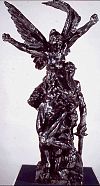 In Paris, a competition starts for a monument about the Franco-Prussian War;
when the entries are judged, Rodin's outline for 'Call to arms' is not even mentioned. His outline for a statue of the Republic which he later calls
'Bellona' - also with Rose as model - has just as little success. In Paris, a competition starts for a monument about the Franco-Prussian War;
when the entries are judged, Rodin's outline for 'Call to arms' is not even mentioned. His outline for a statue of the Republic which he later calls
'Bellona' - also with Rose as model - has just as little success.
Rodin executes his second large statue, the monumental 'St. John the Baptist Preaching'.
He works part-time as a modeller in the Manufacture de Sèvres, where Carrier-Belleuse
has been the director since 1876. Rodin decorates a number of vases and
develops a new technique of drawing directly in the soft paste. The new
director, Charles Lauth, rejects Rodin's work and orders to throw one of
his first two vases away. The other vase, titled 'L´Elements', attracts positive public
attention and Lauth is forced to give it a worthy place in the Sèvres
Museum.
|
|
1880
|
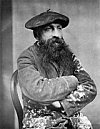 He receives the commission for a statue of d'Alembert for the Hôtel de
Ville. He receives the commission for a statue of d'Alembert for the Hôtel de
Ville.
On 11 Jan. Rodin has an interview with Turquet, state undersecretary
for Fine Arts, who
wants to commission a bronze cast of the 'Age of Bronze', but needs an
expertise contradicting the accusations raised in Belgium. A commission
headed by deputy inspector Roger Ballu, however, does not believe Rodin
has been able to model the work without surmoulage. Together with
Turquet's protégé, Maurice Haquette, Rodin prepares a testimony, dated
23 Febr., signed by the best-known sculptors of that time, confirming
Rodin's outstanding abilities.
'St. John the Baptist Preaching' and 'The Age of Bronze' are shown in the
Salon; the latter wins a third-class medal and is finally purchased by the state.
In August, it wins a gold medal in Ghent. Now the way is free for Rodin's
career as an artist sculptor.
Rodin is beginning to frequent the salon of Mme Edmond Adam and Mme de Lionville, where he meets
the writers Guy de Maupassant and Stéphane Mallarmé.
Supported by Turquet, Rodin receives a further state commission to design a decorative portal of the proposed
Musée des Arts Décoratifs based on the theme of Dante's 'Divine
Comedy'. Rodin was inspired by Ghiberti´s Gate of Paradise in
Florence which he had seen during his trip to Italy. Later, Rodin chose a
composition which divides the door into various sections or leafs, based
on the example of Michelangelo's Last Judgement in the
Sistine Chapel.
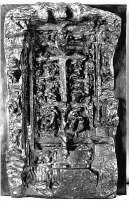 'The Gates of Hell' shows a great number of figures,
representing the damned souls trying to save themselves from the eternal
flames. The most prominent subjects are the 'Thinker', representing the poet Dante,
and the illicit love couple Francesca da Rimini and Paolo Malatesta,
stabbed by Francesca's jealous husband.
'The Gates of Hell' shows a great number of figures,
representing the damned souls trying to save themselves from the eternal
flames. The most prominent subjects are the 'Thinker', representing the poet Dante,
and the illicit love couple Francesca da Rimini and Paolo Malatesta,
stabbed by Francesca's jealous husband.
Rodin will be preoccupied by the 'Gates' over nearly 40
years; but during his lifetime the plaster models never will be cast in
bronze. Only by commission of the American collector Jules Mastbaum a
bronze cast is made in 1926; a second cast is presented to the Musée
Rodin. But many couples and single figures from the 'Gates' will be
re-created as independent sculptures and worked out in bronze and marble
during Rodin's lifetime.
To facilitate his intensive work on 'The Gates of Hell' and other commissions by the state, he is given the state-owned studios in the
Dépôt des Marbres at the Rue de l´Université. At first he works in Studio M, in 1883
he gets Studio H for himself, in 1890 he will be given Studio J, where he
continues to work on the 'Gates of Hell'.
Works on
'The Thinker', 'Young Woman with Child', 'The Limbo' and 'The Sirenes'.
|
|
1881
|
Rodin makes the first of many trips to England; he is meeting his friend Alphonse Legros in London and learns the technique of
drypoint.
He also meets William Ernest Henley, Director of the Magzine of
Art, and Robert Louis Stevenson. He loves the colours of the city
and the Elgin Marbles in the British Museum.
 He works on 'The Shades' and 'Eve'. One of Rodin's most-quoted anecdotes
tells us he saw his model's appearance change from session to session. Rodin adapted
his profiles till he learned one day that his model was pregnant. Rodin
appreciated this as good luck because the accident led him to presenting
Eve as the mother of mankind. Since his model, one of the Abruzzezzi
sisters, left on a maternity leave with one of Rodin's assistants and did not
return, however, Rodin was not able to finish the modeling.
He works on 'The Shades' and 'Eve'. One of Rodin's most-quoted anecdotes
tells us he saw his model's appearance change from session to session. Rodin adapted
his profiles till he learned one day that his model was pregnant. Rodin
appreciated this as good luck because the accident led him to presenting
Eve as the mother of mankind. Since his model, one of the Abruzzezzi
sisters, left on a maternity leave with one of Rodin's assistants and did not
return, however, Rodin was not able to finish the modeling.
Rodin's 'St. John the Baptist Preaching' is bought by the state.
|
|
1882
|
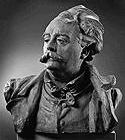 Rodin begins a series of portrait busts of colleagues and writers,
e.g. Carrier-Belleuse in terra-cotta. Rodin begins a series of portrait busts of colleagues and writers,
e.g. Carrier-Belleuse in terra-cotta.
The Claudel family moves to Paris, to enable Camille to
pursue her artistic ambitions. In her atelier, at the 117 Rue Notre-Dame-des
Champs, Camille organizes a sculpure class, mainly consisting of young English women and
supervised by Alfred Boucher, who had taught her since she was fifteen.
Rodin now exhibits in
the Salon every year. Further exhibitions at the Triennal Salon in Paris and at the
Royal Academy and the Grosvenor Gallery in London. Intensive
work on 'The
Gates of Hell' and 'Ugolino'. 'Torso of Adèle'.
|
|
1883
|
Rodin agrees to supervise Boucher's sculpture course during his absence
and so meets Camille. Rodin falls in love with his talented pupil, Camille recognizes her chance to be tutored by the greatest
sculptor talent of her time, who is just breaking through to fame. A love
letter, that for a long time has been suppressed and
finally turned up in the house of Cécile Goldscheider, proves that
already by the fall of 1883, while Camille is still 18, Rodin and Camille had an intimate
relationship.
The artist writes to his "ferocious
friend":
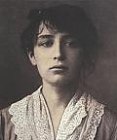 "This morning I ran around (for hours) to all our spots without
finding you. Death would be sweeter! And how long is my agony. Why didn't
you wait for me in the atelier, where are you going? (...) In a single
instant I feel your terrible force. Have pity, mean girl. I can't go on. I
can't go another day without seeing you. Atrocious madness, it's the end,
I won't be able to work anymore. Malevolent goddess, and yet I love you
furiously... . (...) Let me see you every day, which would be a good idea
and might make me better, for only you can save me with your generosity.
Don't let this slow and hideous sickness overtake my intelligence, the
ardened and pure love I have for you - in short, have pity, my beloved,
and you will be rewarded."
"This morning I ran around (for hours) to all our spots without
finding you. Death would be sweeter! And how long is my agony. Why didn't
you wait for me in the atelier, where are you going? (...) In a single
instant I feel your terrible force. Have pity, mean girl. I can't go on. I
can't go another day without seeing you. Atrocious madness, it's the end,
I won't be able to work anymore. Malevolent goddess, and yet I love you
furiously... . (...) Let me see you every day, which would be a good idea
and might make me better, for only you can save me with your generosity.
Don't let this slow and hideous sickness overtake my intelligence, the
ardened and pure love I have for you - in short, have pity, my beloved,
and you will be rewarded."
These words already contain the essence of the drama that will unfold over
the next 15 years: with her indifference and whims, Camille torments Rodin, wo in
turn prospects a reward that in the end, he can and will not give - the
only reward Camille is striving for, an exclusive bond between two equal
partners, remains unattainable.
Camille will be his model, his assistant, his artist-colleague and his
lover, but Rodin will not give up his ties with Rose.
Rodin is still working on the portrait series of artists (Dalou,
Haquette, Becque) and on a bust of Victor Hugo.
After the death of his father he moves from the
Rue des Fossés Saint-Jaques to the Rue du Faubourg
Saint-Jaques.
|
|
1884
|
Opening of the Salon des
Indépendants.
|


|